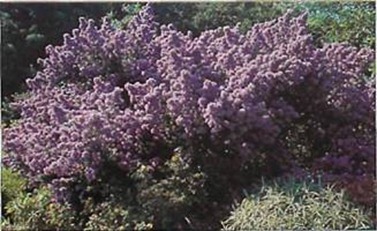





Set your garden alight with colourful shrubs. All year round there need never be a dull moment, and they become more and more attractive as they mature.
There is a vast range to choose from in almost every garden centre.
Shrubs have many advantages over annuals and perennials. They are permanent plants and, in many cases, colourful over a much longer season.
Bright bedding schemes and beautiful herbaceous borders are not the only means of adding colour to your garden.
A carefully chosen display of shrubs can provide an array of subtle or striking colours.
Shrubs offer colours in four main ways:
• flowers
• leaves
• stems
• berries.
 Sometimes these work individually but more often in combination. Different parts of a shrub often change throughout the seasons. For example, in the depths of winter the crimson stems of dogwood are breathtaking, particularly in frost or snow, while in autumn its berries are more prominent.
Sometimes these work individually but more often in combination. Different parts of a shrub often change throughout the seasons. For example, in the depths of winter the crimson stems of dogwood are breathtaking, particularly in frost or snow, while in autumn its berries are more prominent.
IMPORTANT
Many gardeners love the colours of leaf variegation. There are variegations of many shades: light green, white, cream, yellow and pink. Variegated plants blend with most shrubs, which do not have variegated leaves, provided that there is a colour link. Mixing different variegations together, on the other hand, needs some restraint.
Contrasting shades of shrub colours are generally more stimulating than harmonies, which tend to be restful. With some shrubs the contrast lies between its own leaf and flower colour, while others enjoy a natural harmony.
Rosaglauca, with dark pink flowers and stems, is a picture of harmony, but the scarlets and purples of fuchsia flowers against its green leaves is stirring.
Some shrubs, such as Photinia x fraseri ‘Red Robin’ have bronze-red young growth, combined with green in the lower leaves, as does Stransvaesia davidiana, which at the onset of autumn has both green and scarlet leaves.
Shrubs such as the smoke bush Cotinus coggygria ‘Purpureus group’ and Corylus maxima ‘Purpurea’, however, are purple all summer and then display wonderful autumn tints.
The pale greens and yellows of flower and leaf bring light to the dullest days, as do blue flowers and grey-green leaves. The evergreen Ceanothus is an example, with its natural colour harmony.
When planning your display, check ultimate sizes and when the particular shrub is at its best. As well as considering the colours of the shrub’s flowers, leaves, stems and fruit, work out what time of the year it will be most effective in your garden.
With this knowledge, select other shrubs for harmony or contrast. You may have a special colour theme in mind, perhaps concentrating on shrubs with particular flower hues or autumn colours.
Alternatively, you might want to single out a particular plant. Some shrubs, such as magnolia or one of the Japanese maple varieties, make excellent focal points. They look best set against a neutral background.
Final checks
Try to keep to your intended plant and resist the temptation of impulse buying. The best way is to write down your plan and take it with you to the garden centre.
Finally, always check your garden’s soil type and aspect before buying any shrub. This way your shrubs will thrive and provide for many years the colour you expected.
TIP
A BORDER PLAN
There are so many shrubs of every colour, size and growing requirement that it is often difficult to choose. It helps to make a scale plan of the area to be planted. Use graph paper, letting each square represent a square metre and one shrub. In each, write in order, spring, summer, autumn, winter until the squares are filled, devoting one sea.son to each square. Write in the name of a shrub with the best colour at that particular season in each square. Fine tune the plan in terms of harmony or contrast and ultimate shrub size: some take up more than a square metre and others less.
POPULAR VARIETIES
Common name
Latin name
Colour
Red Japanese maple
Acer palmatum f. atropurpureum
dark red leaves
Box elder
Acer negundo
yellow and pale green
‘Aureovariegatum’
variegated leaves
Barberry
Berberis thunbergii f. atropurpurea
purple and wine red leaves
Butterfly bush
Buddieja davidii
cream-white variegated leaves,
‘Harlequin’
red-purple flowers
Ling
Calluna vulgaris
golden foliage,
‘Gold Haze’
white flowers
Purple hazel
Cotylus maxima ‘Purpurea’
deep purple leaves
Evergreen spindle
Euonymus fortunei
gold variegated leaves,
‘Emerald’n’Gold’
pink winter tints
Honey locust
Gleditsia triacanthos ‘Sunburst’
yellow leaves
Privet
Ligustrum ovalifolium
semi-evergreen
‘Aureum’
yellow variegated leaves
Flame of the forest
Pieris japonica
pink new growth,
‘Variegata’
white variegated leaves
New Zealand flax
Phormium cookianum
green, white and
ssp. hookeri ‘Tricolor’
red variegated leaves
Dwarf purple cherry
Prunus x cistena
bronze foliage,
‘Crimson Dwarf’
red and white flowers
Weigela
Weigela florida
purple foliage,
‘Foliis Purpureis’
pink flowers
BUYING TIP
To help you make the best choices for your garden, visit arboreta (botanical gardens devoted to shrubs and trees) and established gardens. These provide a chance to see mature colourful shrubs growing together, and offer ideas which you can put into practice at home.
Copyright © www.100flowers.win Botanic Garden All Rights Reserved